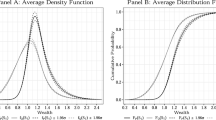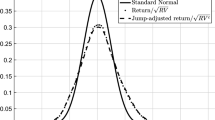Abstract
We propose a new method to jointly estimate volatility risk and two-tail risk price with state-dependent features. Rather than assuming a constant risk price, as in existing models, this new method estimates an extended pricing kernel with macro-state-dependent risk prices. In contrast to the widely accepted constant risk price assumption, we find that the prices for equity, volatility, positive jump, and negative jump risks are strongly dependent on economic conditions. The empirical evidence shows that this new estimation for the macro-state-dependent property adds new pricing information that existing constant risk-price models do not provide. The estimation of macro-state-dependent property has important economic implications for the underlying dynamics and derivative markets. State-dependent risk prices substantially improve the explanation of the dynamic link between the underlying and option markets, and are important factors in the option market. With the out-of-sample test, the new method provides a stable estimation of the risk price dynamics.

Similar content being viewed by others
Notes
When the extreme value distribution is of the Frechet type, the rate of decay of the tails is approximately the same as that of the power law. The double exponential tails decay at the same rate as the power speed. Thus, we can approximately represent a general type of positive and negative jumps by an exponential distribution when the jumps are large enough.
We adopt a similar specification as that in Bollerslev et al. (2011), where we use the AR(1) process to estimate the dynamic of the volatility premium. This specification simplifies our estimation while maintaining a parsimonious autocorrelation structure.
This result is based on results in Bollerslev et al. (2011).
We can compute the variance of jumps explicitly based on the jump parameters:\( {\text{var}}\left( {\mathop \int \limits_{t}^{t + \Delta } \mathop \int \limits_{{\mathbb{R}}} \left( {e^{x} - 1} \right)\tilde{\mu }_{J}^{Q} \left( {{\text{d}}x,{\text{d}}t} \right)} \right) = \frac{{2\psi_{t}^{ + } \Delta }}{{\alpha_{t}^{ + ,Q} \left( {\alpha_{t}^{ + ,Q} - 1} \right)\left( {\alpha_{t}^{ + ,Q} - 2} \right)}} + \frac{{2\psi_{t}^{ - } \Delta }}{{\alpha_{t}^{ - ,Q} \left( {\alpha_{t}^{ - ,Q} + 1} \right)\left( {\alpha_{t}^{ - ,Q} + 2} \right)}} \). Bollerslev and Todorov (2014) and Bollerslev et al. (2015) estimate the jump parameters \( \alpha_{t}^{ \pm ,Q} {\text{and}} \psi_{t}^{ \pm } \). We use their approach to estimate these jump parameters for the moment conditions in the GMM.
We estimate the covariance matrix using heteroskedastic and autocorrelation-robust approaches.
The estimation uses the five-minute S&P 500 time series. According to Lee and Mykland (2008), the likelihood of misclassification by spurious detection of jumps and a failure to detect actual jumps is negligible at price data frequencies of 15 min or higher.
In an unreported result, we use a regression with the overlapping one-year sample period to examine the consistency of the high-frequency time series. The result confirms that the two types of the five-minute S&P 500 time series are extremely close, with a correlation more than 0.99.
When we calculate the model-implied premia, we estimate the Q-measure expectations using the option data; that is \( \widehat{IV}_{t} \) and \( \hat{\alpha }_{t}^{ \pm ,Q} \), and calculate the P-measure expectations based on the state-dependent risk price model in Sect. 2.
The details of the estimation of the moments in the Q-measure return distribution can be found in Bakshi et al. (2003), who established the model-free method using derivatives market data.
A more comprehensive question is what is the best selection of variables, though we do not discuss this issue here because an analysis needs at least \( 2^{28} \left( {4 {\text{risk prices}} \times 7 {\text{variables}}} \right) \) times likelihood maximization to select the most relevant variables in the model under the AIC or BIC framework.
Although the out-of-sample periods (52 weeks and 104 weeks) seem much shorter than the in-sample period, it contains a time interval of around one to two years. Because we use seven state variables, we need to estimate 40 parameters. A decrease in the in-sample period length can significantly reduce the accuracy of this estimation.
References
Aı̈t-Sahalia Y (2004) Disentangling diffusion from jumps. J Financ Econ 74(3):487–528. https://doi.org/10.1016/j.jfineco.2003.09.005
Andersen TG, Fusari N, Todorov V (2015a) The risk premia embedded in index options. J Financ Econ 117(3):558–584. https://doi.org/10.1016/j.jfineco.2015.06.005
Andersen TG, Fusari N, Todorov V (2015b) Parametric inference and dynamic state recovery from option panels. Econometrica 83(3):1081–1145. https://doi.org/10.3982/ECTA10719
Bakshi G, Cao C, Chen Z (1997) Empirical performance of alternative option pricing models. J Finance 52(5):2003–2049. https://doi.org/10.1111/j.1540-6261.1997.tb02749.x
Bakshi G, Kapadia N, Madan D (2003) Stock return characteristics, skew laws, and the differential pricing of individual equity options. Rev Financ Stud 16(1):101–143. https://doi.org/10.1093/rfs/16.1.0101
Bansal R, Yaron A (2004) Risks for the long run: a potential resolution of asset pricing puzzles. J Finance 59(4):1481–1509. https://doi.org/10.1111/j.1540-6261.2004.00670.x
Barndorff-Nielsen OE, Shephard N (2004) Power and bipower variation with stochastic volatility and jumps. J Financ Econom 2(1):1–37. https://doi.org/10.1093/jjfinec/nbh001
Bollerslev T, Todorov V (2011) Tails, fears and risk premia. J Finance 66(6):2165–2211. https://doi.org/10.1111/j.1540-6261.2011.01695.x
Bollerslev T, Todorov V (2014) Time-varying jump tails. J Econom 183(2):168–180. https://doi.org/10.1016/j.jeconom.2014.05.007
Bollerslev T, Zhou H (2006) Volatility puzzles: a simple framework for gauging return-volatility regressions. J Econom 131(1):123–150. https://doi.org/10.1016/j.jeconom.2005.01.006
Bollerslev T, Tauchen G, Zhou H (2009) Expected stock returns and variance risk premia. Rev Financ Stud 22(11):4463–4492. https://doi.org/10.1093/rfs/hhp008
Bollerslev T, Gibson M, Zhou H (2011) Dynamic estimation of volatility risk premia and investor risk aversion from option-implied and realized volatilities. J Econom 160(1):235–245. https://doi.org/10.1016/j.jeconom.2010.03.033
Bollerslev T, Todorov V, Xu L (2015) Tail risk premia and return predictability. J Financ Econ 118(1):113–134. https://doi.org/10.1016/j.jfineco.2015.02.010
Boudoukh J, Michaely R, Richardson M, Roberts MR (2007) On the importance of measuring payout yield: implications for empirical asset pricing. J Finance 62(2):877–915. https://doi.org/10.1111/j.1540-6261.2007.01226.x
Boyer BH, Vorkink K (2014) Stock options as lotteries. J. Financ 69(4):1485–1527. https://doi.org/10.1111/jofi.12152
Campbell JY, Cochrane JH (1999) By force of habit: a consumption-based explanation of aggregate stock market behavior. J Polit Econ 107(2):205–251. https://doi.org/10.1086/250059
Carr P, Wu L (2009) Variance risk premiums. Rev Financ Stud 22(3):1311–1341. https://doi.org/10.1093/rfs/hhn038
Chen H, Joslin S, Ni SX (2019) Demand for crash insurance, intermediary constraints, and risk premia in financial markets. Rev Financ Stud 32(1):228–265. https://doi.org/10.1093/rfs/hhy004
Christoffersen P, Heston S, Jacobs K (2009) The shape and term structure of the index option smirk: why multifactor stochastic volatility models work so well. Manag Sci 55(12):1914–1932. https://doi.org/10.1287/mnsc.1090.1065
Christoffersen P, Heston S, Jacobs K (2013) Capturing option anomalies with a variance-dependent pricing kernel. Rev Financ Stud 26(8):1963–2006. https://doi.org/10.1093/rfs/hht033
Drechsler I, Yaron A (2011) What’s vol got to do with it. Rev Financ Stud 24(1):1–45. https://doi.org/10.1093/rfs/hhq085
Du D (2011) General equilibrium pricing of options with habit formation and event risks. J Financ Econ 99(2):400–426. https://doi.org/10.1016/j.jfineco.2010.09.001
Eraker B (2004) Do stock prices and volatility jump? Reconciling evidence from spot and option prices. J Finance 59(3):1367–1403. https://doi.org/10.1111/j.1540-6261.2004.00666.x
Ferri MG, Min C (1996) Evidence that the stock market overreacts and adjusts. J Portf Manag 22(3):71–76. https://doi.org/10.3905/jpm.1996.409553
Garleanu N, Pedersen LH, Poteshman AM (2009) Demand-based option pricing. Rev Financ Stud 22(10):4259–4299. https://doi.org/10.1093/rfs/hhp005
Heston SL (1993) A closed-form solution for options with stochastic volatility with applications to bond and currency options. Rev Financ Stud 6(2):327–343. https://doi.org/10.1093/rfs/6.2.327
Johnson TL (2017) Risk premia and the VIX term structure. J Financ Quant Anal 52(6):2461–2490. https://doi.org/10.1017/S0022109017000825
Kelly B, Jiang H (2014) Tail risk and asset prices. Rev Financ Stud 27(10):2841–2871. https://doi.org/10.1093/rfs/hhu039
Lashgari M (2000) The role of TED spread and confidence index in explaining the behavior of stock prices. American Business Review 18(2):9–10
Lee SS, Mykland PA (2008) Jumps in financial markets: a new nonparametric test and jump dynamics. Rev Financ Stud 21(6):2535–2563. https://doi.org/10.1093/rfs/hhm056
Neumann M, Prokopczuk M, Simen CW (2016) Jump and variance risk premia in the S&P 500. J Bank Finance 69:72–83. https://doi.org/10.1016/j.jbankfin.2016.03.013
Pan J (2002) The jump-risk premia implicit in options: evidence from an integrated time-series study. J Financ Econ 63(1):3–50. https://doi.org/10.1016/S0304-405X(01)00088-5
Schmeling M (2009) Investor sentiment and stock returns: some international evidence. J Empir Finance 16(3):394–408. https://doi.org/10.1016/j.jempfin.2009.01.002
Acknowledgement
This research did not receive any specific grant from funding agencies in the public, commercial, or not-for-profit sectors.
Author information
Authors and Affiliations
Corresponding author
Ethics declarations
Conflict of interest
The authors declare that they have no conflict of interest.
Additional information
Publisher's Note
Springer Nature remains neutral with regard to jurisdictional claims in published maps and institutional affiliations.
Electronic supplementary material
Below is the link to the electronic supplementary material.
Rights and permissions
About this article
Cite this article
Chen, S., Gu, Y. Joint estimation of volatility risk and tail risk premia with time-varying macro-state-dependent property. Rev Quant Finan Acc 56, 1357–1397 (2021). https://doi.org/10.1007/s11156-020-00925-6
Published:
Issue Date:
DOI: https://doi.org/10.1007/s11156-020-00925-6




